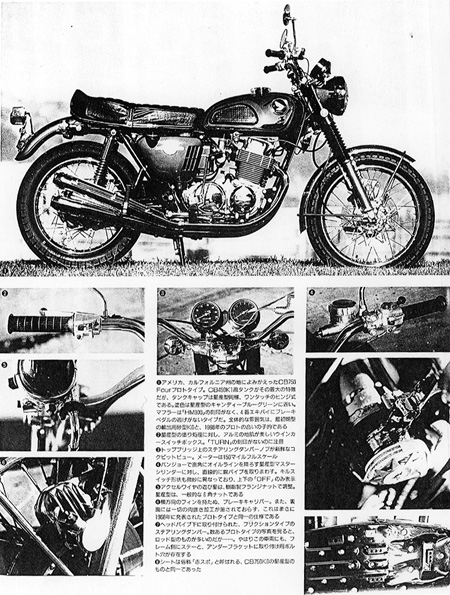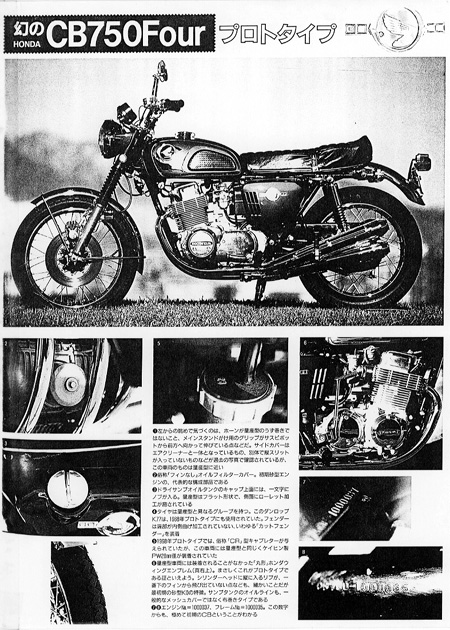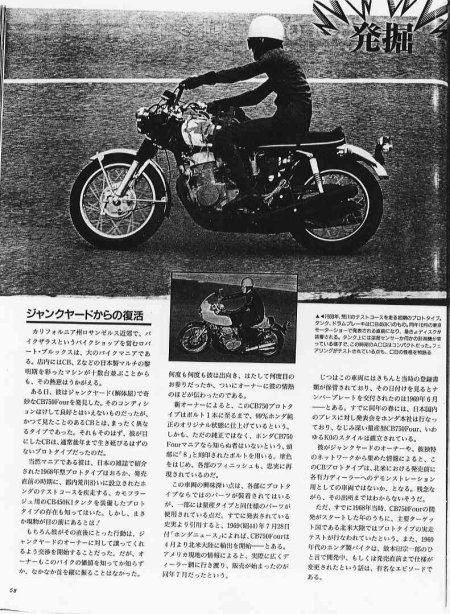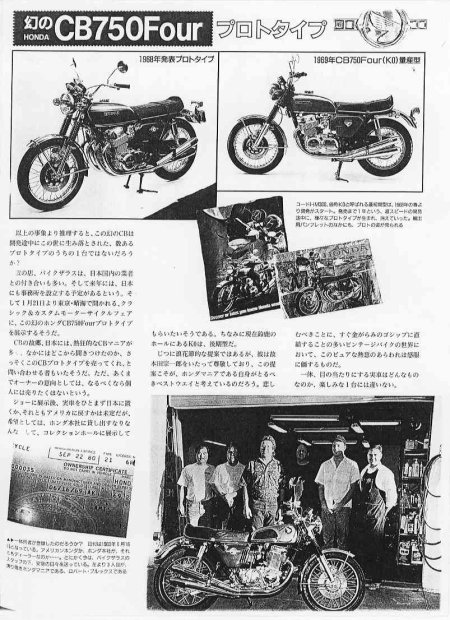CB750 History
25TH ANNIVERSARY ARTICLES
This is a series of articles that tells the story of the 9 year history of the CB750, the bike that arguably had the greatest impact on motorcycling of any single model.
A Bike to Remember This article, from a 1994 Cycle World issue, is a collection of quotes that date from the introduction of the CB750 in 1969.
Milestone Motorcycle A 1994 Old Bike Journal article about the historical significance of the CB750.
The Dream CB750 Four This page on Honda’s website tells the story of the development of the CB750 Four.
The CB750 Prototype
This story is the translation of an article published in Japan describing Robert Brooks of California and his, reputed, CB750 prototype. Later information suggests that this bike is a modern replica of the prototype bikes that made the rounds of west coast dealers in 1968. Thanks to Joe Broussard for providing the photos and the article; and Munekazo Shimizu, SOHC/4 #256 for the translation.

- In California, USA, a CB750 four prototype was reborn. The most remarkable difference is a CB450 K1-like fuel tank, by the way, a fuel cap is a same easy-open-hinge type which was used for mass production CB750s. A color scheme is close to well known Candy bluegreen. Mufflers don’t have a curved seal, HM300 and also #4 header pipe is without the dent for rear brake pedal. A whole image is somewhere between the first export model (sand cast K0) and a 1968 prototype.
- A turn signal switch unit is beautiful polished aluminum without “TURN” on the unit. On the other hand, K0 has a painted one.
- A steering damper on the top bridge gives the meter panel a fresh view. The speedo has up to 150mph on its scale.
- A steel brake pipe comes out straight from master cylinder unit. On the other hand, K0′s oil line goes down at right angle with banjo joint. The shape of the Kill Switch is slightly different from K0, and switch doesn’t have “On” in the middle.
- A plastic throtle free adjusting nut. K0 has ordinal metal nut.
- A brake caliper doesn’t have holizontal cooling fins on it. On the back side of the caliper, there’s no curving to lighten the weight of the caliper. This was seen on another prototype introduced in 1968.
- A friction-type steering damper is installed down below the head pipe. According to lots of pics of other prototype, the damper was usually a rod-type. Needless to say, the bike also has a hole on the steering stem and a stay on the main frame for future installation of the damper.
- A seat, so called “Red Supo”(?), is the same type on K0.

[No translation provided. Please post a comment if you are able to translate the text of this page]

Robert Brooks, running a motorcycle shop called Bikesurus near Los Angeles, California., is a real motorcycle enthusiast. Early Japanese multi-cylinder bikes, such as CB, Z, etc., in his shop are the proof of his passion to motorcycles.
One day, he found a strange CB750 four at the junk yard by chance. The CB wasn’t in good condition, however, he had never seen the kind of CB before. Sure, the CB he saw is a rare prototype CB which usually can’t be survived for a long time. He did know about the prototype CB introduced in 1968 by one of the Japanese bike magazine. He also saw the picture of the prototype-CB with a CB450K1′s fuel tank for camouflage running on test track in Tokyo, Japan. Holly s***, the bike was then in front of him! He of course started negotiating with the owner of the bike. However the owner was die-hard if he knew anything about the bike or not. After lots of visits to the junk yard, he finally could manage to get the prototype-CB.
According to Brooks, he restored the bike in stock condition with 99% genuine Honda parts. Of course, he did use bolts, well-known among CB enthusiast, with punched seal ”8” on its head.(??) Also a color scheme and some other details were completely restored in original condition. The most interesting point on the bike is that the bike is made up with both special parts for the prototypes and regular parts for K0 and later.
Honda News, July 28th, 1969, says that Honda started to export CB750 four to the U.S. in April, 1969. Another information in the states says it was July in 1969 that all Honda dealers in the U.S. got ready to sell CB750. In fact, the prototype-CB has its original title registered in June, 1969. In Spring, 1969, Honda already introduced a K0 to the Japanese press, and this means that the style of K0 was completed by the time. Brooks assumes that the bike was used for the pre-sales-demo to major Honda dealer in the U.S. according to his own research. However, the truth is still unknown. By the way, in 1968, when Honda started the development project of CB, the prototype was actually tested in the U.S., too. Because the U.S. is Honda’s main target market outside of Japan. Soichiro Honda got all control on any motorcycles made in 1960s. Whenever he thought any change should be made, he did make it, even a bike was under development or just before the shipping.
About the picture: Early prototype is running on the Arakawa test course, Tokyo, Japan, 1968. Fuel tank and F & R drum brake is from CB450K1. In Oct, 1968, just before Tokyo Motor Show, Honda decided to install a front disk brake on CBs. There is some testing devices on the fuel tank. A cowling was also tested. This tells the potential of CB was really high.

We assume that this CB is exactly one of the prototypes which is born during the CB development. Brooks’ shop, Bikesurus, has a close connection with some bike shops in Japan. Bikesurus plans to have a Japanese brunch next year. He will display his prototype-CB at the Classic & Custom bike show in Tokyo starts from Jan 22. Some CB funs already asked him to sell the CB but he doesn’t want to sell the bike to a private owner. He really respects Soichro Honda, and believes that the prototype-CB should be in a Honda’s collection hall in Suzuka, Japan. He also thinks this is the best way that he can do as a one of Honda CB enthusiasts.
Top Picture: Left: 1968 Prototype Right: 1969 CB750 four (K0) Code name, HM300, so called K0, was developed within a year!!! During the development, lots of prototypes might be born and disappeared…
Who the heck registered the bike? Date is June 16th, 1969. American Honda, Honda or a dealer? Anyway, the bike has enjoyed a quiet life in California. Robert Brooks is the third person from the left in the bottom picture.

Robert Brooks, third from left, is shown with the staff of the Japanese magazine which featured this article. The bike had been shipped over to Japan at the time as Mr Brooks was seeking to learn more about the authenticity of this motorcycle.
Sandcast Bikes
Unable to gauge demand for the new bike accurately, Honda limited its initial investment in the production dies for the CB750 by using a technique called permanent mold casting (often erroneously referred to as sandcasting) rather than diecasting for the engines. Once the demand for the bike became clear, Honda switched over to die casting using production dies for the engine cases. Due to their rarity, the sandcast bikes have been particularly desirable.
The information in this article comes from postings to the SOHC/4 Forums, many forum member, Ted Nomura.
The earliest CB750′s had gravity cast engine cases erroneously referred to as sandcast. The early engine cases, which were made prior to the completion of production casting dies, were actually cast using what is correctly called permanent mold casting which uses metal casting molds not sand. It is the gravity casting method and the molds that results in a rough finish to the part. The later engine cases were cast using a technique called die-casting where the metal was pressure fed into a casting die resulting in a smoother surface finish, better quality control, and a generally stronger part.
There are several distinctive characateristics of this series of engines:
- The engine cases have a distinctive rough finish that resembles the roughness of 400-600 grit sandpaper.
- The engine serial number is CB750E-1007414 or lower.
- The clutch cover is held on with 10 screws – the diecast engines have 11.
The sandcast engines were fitted only to the earliest 1969 models. The first thousand bikes were hand built, mostly in California, as Honda tested the market for this new model. Most of these bikes would have been registered prior to August 1969.
Use caution when buying anything designated as ‘sandcast’ since this is a label often incorrectly tacked on parts and bikes by questionable sellers seeking to drive up prices.
The Honda CB750 Sandcast Only Owners Club is a great resource to learn more about the sandcast CB750.